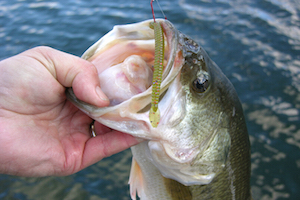Largemouth Bass Feeding Facts

These fish are voracious feeders. Adult largemouth bass are largely fish-eating predators. But the food type changes as they grow from plankton, to insects, to fish, crayfish and frogs.
The largemouth bass is a sight feeder and takes food from the surface, in the water column and off the bottom.
They often feed in schools near shore, close to vegetation.
Lures
- Wondering what lures to use for bass? Experimental studies suggest that when in an aggressive state bass prefer green and blue colors but are repelled by gold and yellow
We recommend using lures that are right for the top sized bass where you’re fishing. This will reduce the number of smaller species from striking your line.
Want to know what bass fish eat?
Crayfish are the top prey for largemouth bass.
Regardless of the watershed, if you fish with crayfish you’re guaranteed a strike. Remember though it’s also the most popular prey for every other freshwater fish.
To find out more about catching and keeping crayfish for bait and crayfish lures click on this link.
Bass avoid brightly lit areas.
Under low light conditions, bass can’t differentiate between lure colors. But color can play a role during the day in clear waters.
This is the reason why the best time for largemouth bass fishing is in the hours around dawn and dusk.
These fish become more active prior to sunset. Then as the sun sets they slow down again until their eyes adjust. This adjustment time varies with the time being longer on sunny days and less on overcast days.
Young or baby bass eat almost anything they catch.
When they’re young, they feed on plankton and insects, moving to fish, crayfish and so on as they grow older.
Adult bass (especially nice big inactive lunker bass) prefer a specialized high-protein diet of golden shiners, shad, crawfish and salamanders.
Despite this preference, bass adapt to the food available in their habitat and therefore can vary greatly across North America.
Your best bet is to find out what prey is popular for a given watershed and fish with that bait.
We’re always amazed at the hunger of the largemouth bass. It’s appetite is so big that it will go after the largest prey it can get in it’s mouth.



